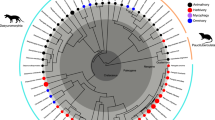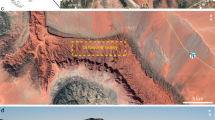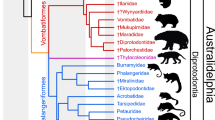Abstract
SIMPSON1 recognizes five superfamilies of living marsupials, three of them Australasian (Dasyuroidea, Perameloidea, Phalangeroidea) and two American (Didelphoidea, Caenolestoidea), and regards none of these as specially related at a higher categorical level. Since Thomas's2 description of Caenolestes obscurus, however, the affinities of the American marsupial superfamily Caenolestoidea have been in doubt largely because of the diprotodont incisors, a feature of their dentition that caenolestoids share with the Australasian phalangeroids. Thus, some authors2–4 have proposed a special relationship between these groups, while others5,6 have rejected the dental similarities as convergent and grouped caenolestoids with the polyprotodont marsupials which include both American and Australasian forms; still others7,8 treat Caenolestoidea as representative of another principal group of marsupials. The question of caenolestoid affinities is thus a problematical one, to which morphological study has contributed little since Osgood's study3. Chromosomal and serological analyses might be expected to be relevant as there have been extensive studies of the chromosomes9–12 and serum proteins13 of four of the marsupial superfamilies. We present here, for the first time, data on the karyotypes and comparative serology of the Caenolestoidea, encompassing three of the seven extant species representing two of the three genera. Details of the localities, ecology and behaviour of these species will be published elsewhere.
This is a preview of subscription content, access via your institution
Access options
Subscribe to this journal
Receive 51 print issues and online access
$199.00 per year
only $3.90 per issue
Buy this article
- Purchase on SpringerLink
- Instant access to full article PDF
Prices may be subject to local taxes which are calculated during checkout
Similar content being viewed by others
References
Simpson, G. G., Bull. Mus. Comp. Zool., 139, 1 (1970).
Thomas, O., Proc. Zool. Soc. for 1895, 870 (1895).
Osgood, W. H., Field Mus. Natural Hist., Zool. Ser., 14, 1 (1921).
Lonnberg, E., Arkiv. Zool., 14, 1 (1921).
Dederer, P., Amer. Naturalist, 43, 614 (1909).
Broom, R., Proc. Linn. Soc. NSW, 36, 315 (1911).
Gregory, W. K., Bull. Amer. Mus. Natural Hist., 27, 1 (1910).
Ride, W. D. L., J. Roy. Soc. W. Austral., 47, 97 (1964).
Sharman, G. B., Austral. J. Zool., 9, 38 (1961).
Biggers, J. D., Fritz, H. I., Hare, W. C. D., and McFeely, R. A., Science, 148, 1602 (1965).
Martin, P. G., and Hayman, D. L., Chromosoma, 20, 290 (1967).
Hayman, D. L., and Martin, P. G., in Comparative Mammalian Cytogenetics (edit. by Benirschke, K.), 191 (Springer, New York, 1969).
Kirsch, J. A. W., Nature, 217, 418 (1968).
Ride, W. D. L., in The Evolution of Living Organisms (edit. by Leeper, G. W.), 281 (University Press, Melbourne, 1962).
Martin, P. G., Nature, 225, 197 (1970).
Author information
Authors and Affiliations
Rights and permissions
About this article
Cite this article
HAYMAN, D., KIRSCH, J., MARTIN, P. et al. Chromosomal and Serological Studies of the Caenolestidae and their Implications for Marsupial Evolution. Nature 231, 194–195 (1971). https://doi.org/10.1038/231194a0
Received:
Revised:
Issue date:
DOI: https://doi.org/10.1038/231194a0
This article is cited by
-
Demographic Parameters of the Silky Shrew-Opossum Caenolestes fuliginosus (Paucituberculata, Caenolestidae) along an Altitudinal Gradient in the Cordillera Central of the Colombian Andes
Journal of Mammalian Evolution (2019)
-
Selected features of marsupial genetics
Genetica (1993)
-
The comparative energetics of neotropical marsupials
Journal of Comparative Physiology B (1978)
-
Continental Drift and the Dispersal and Evolution of Organisms
Nature (1972)



